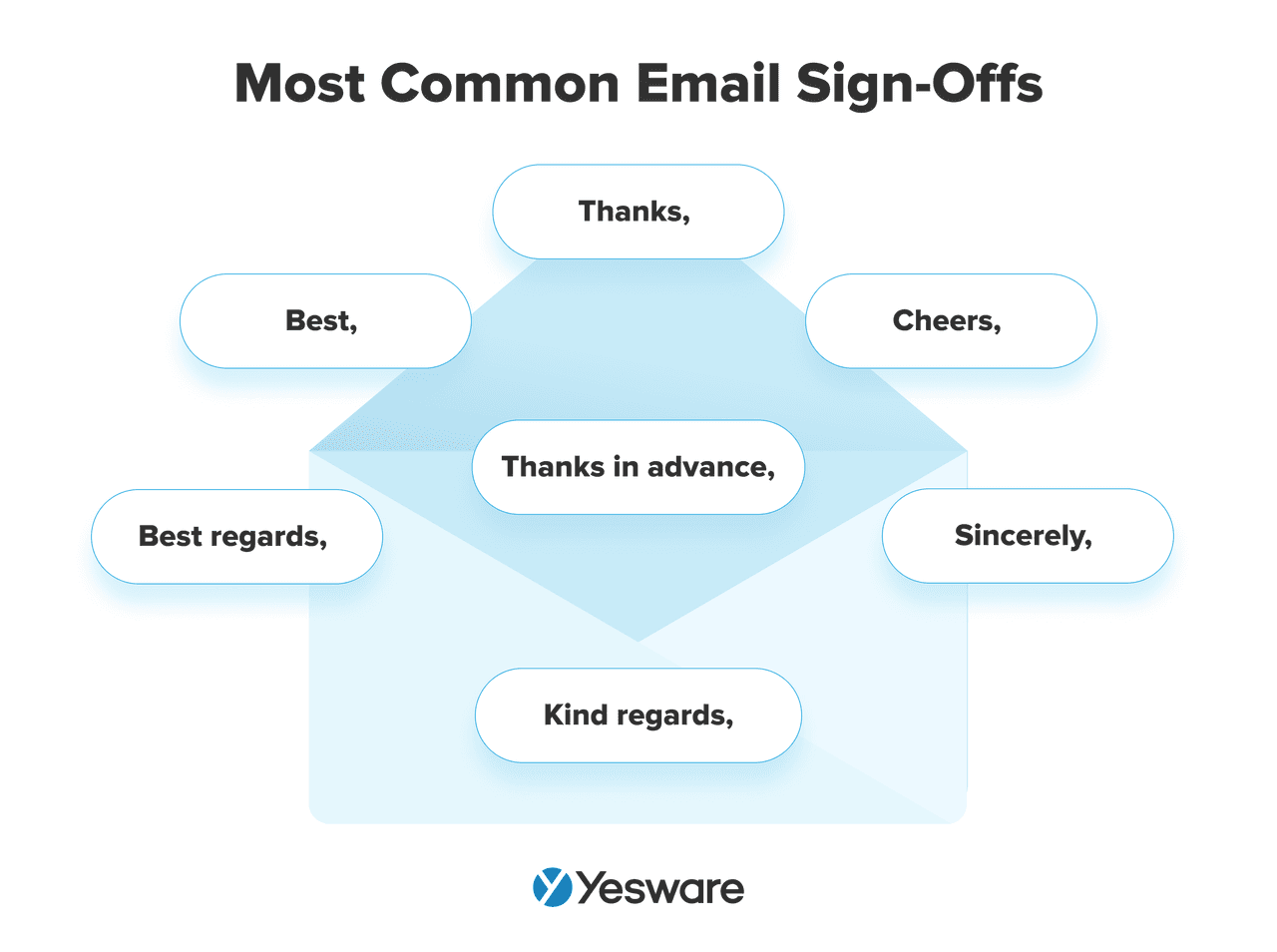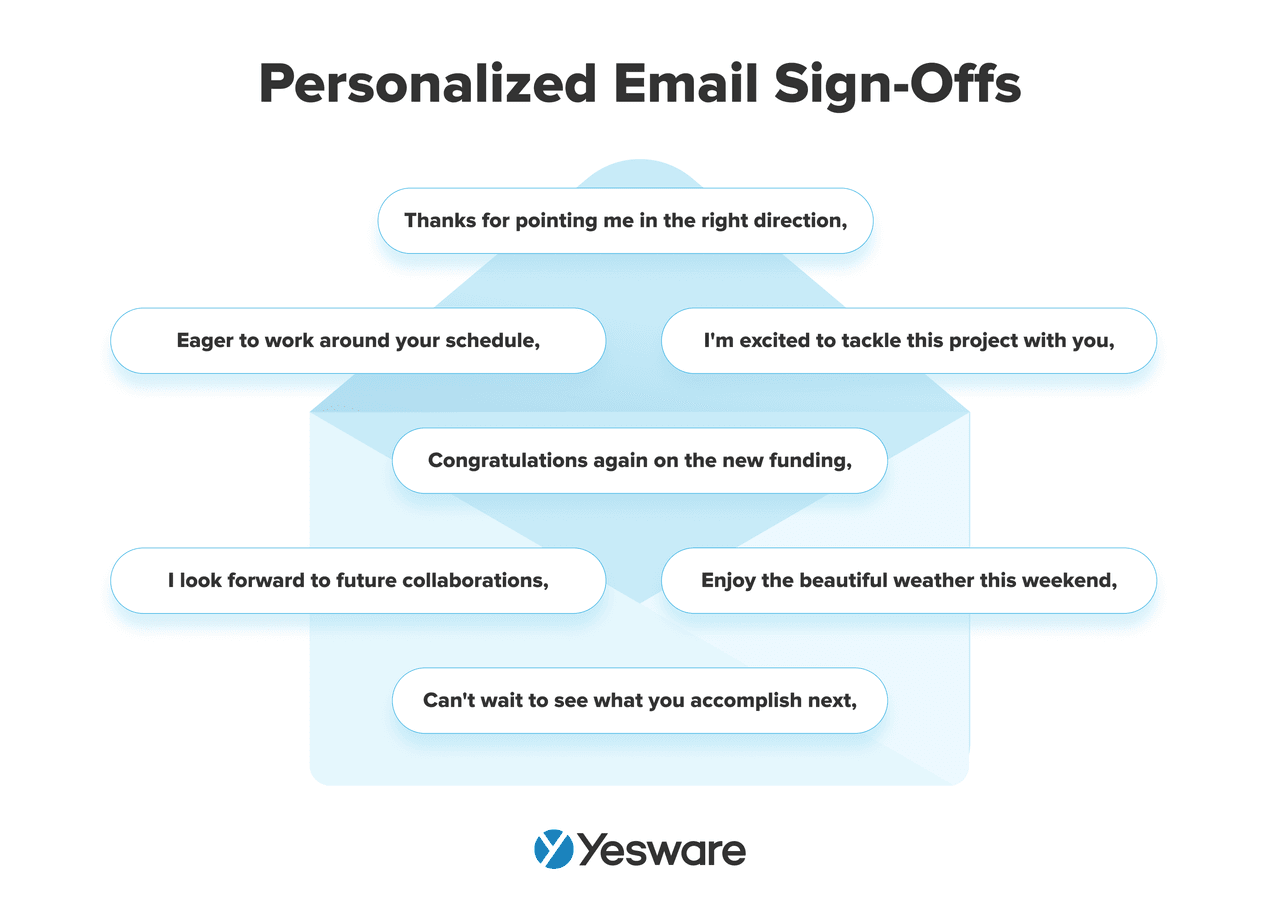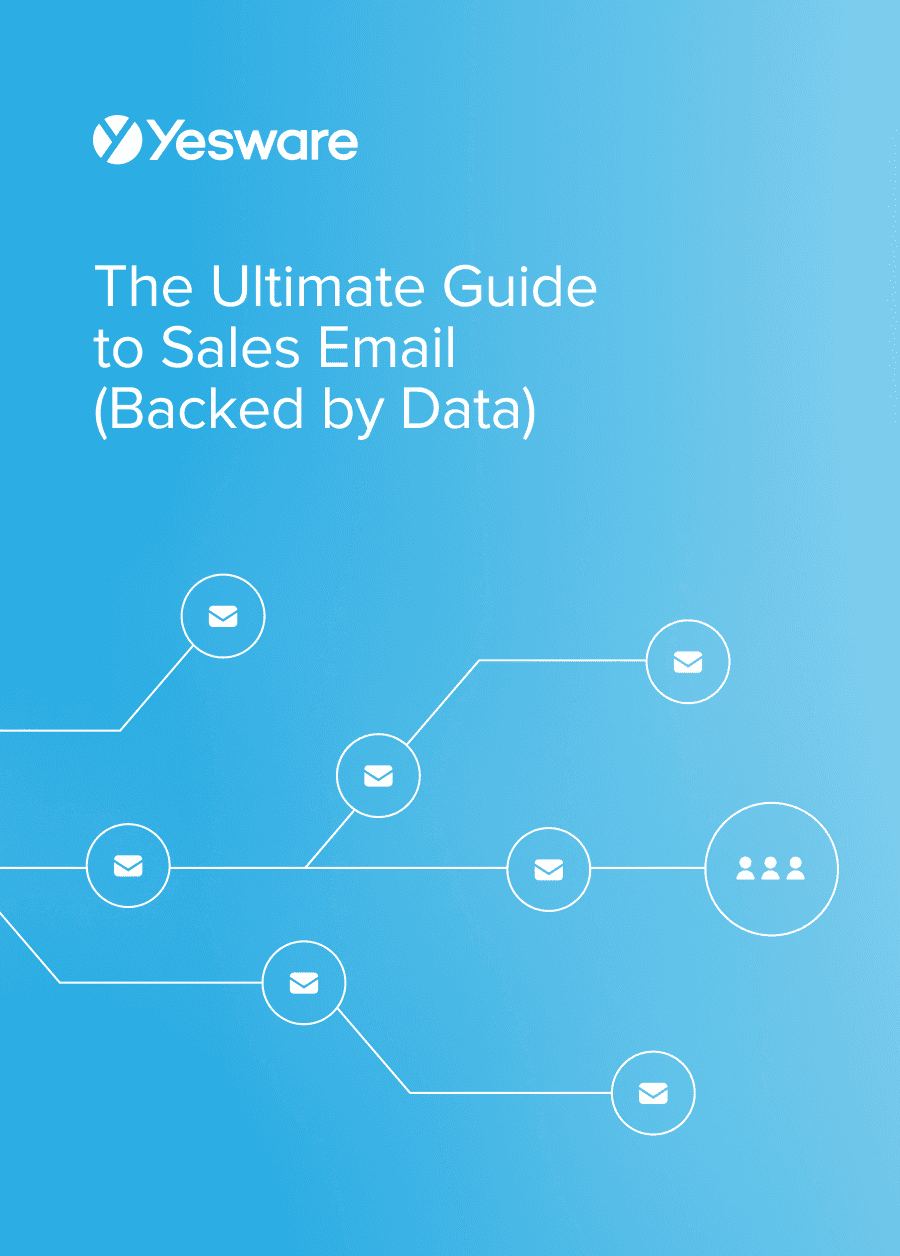How to End an Email: 70 Personalized Email Sign-Offs
Jenny Keohane
When you’re wondering how to end an email, just think about this:
Do you leave a book open when you’re done reading it?
No.
The same holds true when writing a professional email — you need to close it when you’re done.
But don’t just type the same email sign-offs into every message (“sincerely,” “from,” “best regards,” “best wishes,” “warm regards”). Each sign-off should vary depending on the context of your outreach.
Below, we’ve compiled our best practices for ending an email, 70 highly-personalized email sign-offs for various situations, and email closings to avoid.
Here’s what we’ll cover:
- How to End an Email
- General Email Sign-Offs
- Personalized Email Sign-Offs
- Email Sign-Offs to Avoid
- Professional Email Closing Tips
How to End an Email
When you wrap up your email, it’s important to always include an email sign-off.
When it comes to your sign-off, you have two options:
1. General email sign-off: This is a safe route and is perfectly acceptable in professional emails, but it certainly won’t help you stand out from the crowd.

2. Personalized email sign-off: This shows that you’re tailoring your email in real-time to the context of the message you wrote, which helps the message feel more personable.

So, which option should you choose?
A general rule of thumb: personalize your sign-off every time.
Why?
By closing with something memorable, it gives you one last chance to make a good impression.
It’s also important to remember that many recipients skim emails (especially when they’re cold emails). Signing off with personalization gives you another shot at catching their eye.

General Email Sign-Offs
Here are some of the most common ways to end a professional email.
- Sincerely,
- Best,
- Thanks,
- Thank you,
- Kind regards,
- Best regards,
- Regards,
- Thanks in advance,
As stated above, these sign-offs are safe to use and won’t damage your email.
But if you’re looking to change things up, grab one of our personalized email closings below.
Personalized Email Sign-Offs
Email Sign-Offs for When You Need an Answer to a Question
Sign-offs can be catalysts for action when they include a gentle reminder.
As humans, we respond to visual cues. It’s what makes us skip to headlines as we read and what makes sight associations affect our memory.
Research shows that when you associate a task with something in your line of sight, it increases the likelihood of you doing that thing by over 40%.
It’s been tested with elephant statues and stuffed aliens, and it’s an effective way to end an email. Here are some ways to remind your recipient:
1. Sincerely appreciate your help in answering my question,
2. If you’re able to reply by [day or time], that would be great — thank you!
3. Thanks for pointing me in the right direction,
4. Thank you in advance for the help,
5. I appreciate your time and look forward to your response,
Email Closings for When You’re Requesting a Meeting
Keep in mind: your email might be skimmed.
But that’s okay.
According to eye-tracking studies, people read in an “F” pattern. This means that your left-aligned sign-off is the final thing they see in the body of your email.
This creates a final chance to remind them to say “yes” to a meeting.
6. Hoping for a hole in your calendar,
7. Eager to work around your schedule,
8. Looking forward to our conversation,
9. Looking forward to learning more about X,
10. I’m excited to tackle this project with you,
Tip: If you’re sending a sales email, try adding a P.S. line to reiterate: 1) what’s in it for them and 2) the short amount of time being asked for. Here’s an example: P.S. Promise the ROI of [x] minutes with me will be worth it; you’ll walk away with [tangible value].
Email Endings for When You Need Feedback or a Task Completed
According to Harvard Health research, gratitude helps people feel positive emotions and, in turn, builds stronger relationships.
Expressing gratitude also makes people view you more favorably, which is important when you’re asking for something.
Use this to your advantage in your email sign-off:
11. Thanks in advance for your time,
12. I sincerely appreciate your help,
13. Looking forward to your reply,
14. Thanks and let me know if there are any hold-ups,
Tip: If their follow-up might require some time and/or they typically need a second nudge, set a reminder that monitors whether they reply and pings you if they don’t at the day/time you prefer.
How to End an Email When You’re Nurturing a Relationship
You’re familiar with this recipient, so show them you care. End your email by showing the recipient you’re rooting for them.
You can do this by including a piece of content they might find interesting or referencing something that’s relevant to them.
Here’s how to send extra personalized sign-offs that’ll help nurture relationships:
15. Stay awesome,
16. Keep fighting the good fight,
17. P.S. You might find this interesting. (Link “this” to an article they might enjoy.)
18. Congratulations again on X,
19. Enjoy the [event],
20. Go [Prospect’s sports team]!
21. Stay [warm/cold] in [Prospect’s city],
Email Sign-Offs for When You’re Prepping for a Planned Meeting or Project
By addressing that you’re going to be in contact with each other, you leave the lines open for further communication.
Make sure to include your contact information, including your phone number, if you want them to reach you by phone.
22. Talk soon,
23. Speak with you soon,
24. Look forward to connecting soon,
25. Looking forward to chatting, (Specifically for calls)
26. Hope this helps, (If you’re sending content or new information that is valuable to them.)
 The Ultimate Guide to Sales Email (Backed by Data)Looking at the aggregated email habits of more than half a million sales emails, we’ve pulled together the best tips & strategies for improving the outcome of your sales emails.
The Ultimate Guide to Sales Email (Backed by Data)Looking at the aggregated email habits of more than half a million sales emails, we’ve pulled together the best tips & strategies for improving the outcome of your sales emails.
Email Closers for When You’re Sending an Update or Fulfilling a Request
The person (or people) receiving your email might have feedback, questions, or concerns, so bear this in mind. Also, if there’s more information to come, let them know.
27. Stay tuned,
28. More soon, (only if you’re committing to a future update)
29. That’s all for now,
30. Happy to help if you want to know more,
31. Let me know if you have any questions,
How to End an Email When Someone’s Done Something for You
Someone went out of their way to do something for you. Here’s how to end an email with appreciation:
32. Thanks again for [what they did for you — make it a quick phrase],
33. You’re the best,
34. I really appreicate your time,
35. I owe you!
Email Closings When You Feel Comfortable Breaking the Norm
We like these pattern interrupts from Criminally Prolific that help you move away from what everyone else is sending. They also add humor, which can serve as a persuasive tool to increase reply rates.
Here are some funny email closer examples to copy and paste:
36. Have a great day and watch out for falling space stations,
37. Sent from the bottom of my heart, (a play on the typical mobile sign-off)
38. This message made from 100% recycled electrons.
39. FUN FACT: Penguins have knees. (Didn’t know that, ThoughtCatalog)
And for mobile, some funny alternatives to “Sent from my smartphone”:
40. Typed with big thumbs on a small phone,
41. Sent by my carrier pigeon, Percy Finkleberry, (Props to Mashable for this one)
42. Typed on tiny keys, just for you.
43. Written in smoke, translated by warlocks, sent from my palms, (thanks to The Atlantic)
How to Personalize Your Email Sign-Offs According to Send-Time
We all like a good shortcut to getting something done.
Well, sending your message at the best time to send emails no longer means waiting around. You can write it now and schedule it for later, personalizing your email sign-offs for when it will land in their inbox.
Here’s how to do that right from your Gmail inbox. And some examples to play off of:
44. Have a splendid [morning/date/afternoon/evening],
45. Have a great week, (If you’re sending on a Monday or Tuesday and don’t expect an immediate reply).
46. Have a great weekend, (For Fridays)
47. Happy Thursday (we’re almost there!),
48. Happy Friday (T.G.I.F!),
49. Enjoy your holiday,
How to End an Email When You’re Wrapping up a Project or Other Type of Collaboration
You completed a project with someone, and it went great! Now take a second to show some extra appreciation for your collaborator — it’ll go a long way.
With that in mind, here’s how to end a formal email to a collaborator:
50. Great working with you,
51. Thank you for your hard work,
52. It’s been a pleasure working together,
53. I look forward to future collaborations,
54. I hope we can work together again soon,
How to End an Email Replying to a Rejection
Something didn’t work out the way you wanted it to. You’re feeling disappointed, but it’s still important to appreciate the opportunity in the first place. Doing so can actually win you what you lost in the first place — especially in the case of a job where you’ve sent a resume or cover letter.
Be gracious throughout your email and express your desire to keep in touch. Then, sign off by reiterating the sentiment:
55. Thanks for your consideration,
56. Appreciate your time and consideration,
57. I appreciate your time regardless,
58. I hope we can work together soon,
59. If anything changes — I’ll be here,
Email Closings When You’re Sending a Reminder
Another instance of summarizing your main points. If your email was quickly scanned over, reiterate your main point to complete a task.
60. Don’t forget to [action],
61. Again, please [action],
62. If you need to change [time/action] please let me know,
63. I look forward to [action],
64. Don’t hesitate to reach out if you have any questions about [action/task]
Email Endings When You’re Sending a Congratulatory Note
When someone gives you a compliment, you feel obliged to give one back. Right?
It’s called the Rule of Obligation.
You might need a favor from your recipient in the future, so end your email with a final note that further recognizes their accomplishment. It will create subconscious, positive attitudes toward you and your company.
65. Keep up the great work!
66. Congrats again,
67. In awe of what you’ve accomplished,
68. You’re a star!
69. Keep killing it,
70. Can’t wait to see what you accomplish next,
Email Sign-Offs to Avoid
There are some email sign-offs that rub recipients the wrong way. Through thorough research, these seem to be the email closings to avoid.
- Love,
- Thx,
- Yours truly,
- Chat soon,
- Peace,
- Xoxo,
Even if you’re writing these as a joke, you never know how the recipient will read it. Since it’s tricky to communicate sarcasm/comedy in text form, it might be safe to avoid these casual sign-offs for your professional emails.
Professional Email Closing Tips
Remember, your email closing is your last impression. Here are a few more tips for how to end an email professionally.
- Always include a CTA: Never sign off your email without a clear CTA that helps guide the recipient to the intended next step.
- Include a professional email signature: Always include an email signature with your contact information so that recipients have additional methods of communication (aside from your email address) in case they prefer a different channel.
- Keep your email closing short and concise: Don’t drag on your email closing. Remember, many recipients skim emails. If your closing is shorter and easier to digest, there’s more of a chance your recipient will read it.
Save Your Sign-Offs as Templates
With Yesware, you can save your email sign-offs for every type of situation as templates that live in your inbox. Then re-use them whenever you need.

Measure the effectiveness of your emails so you’re always in the know of the most effective email messaging possible.
Continue to iterate and get creative by A/B testing different sign-offs.
Change it up and find what works best for you and your specific audience.
This guide was updated on June 27, 2023.
Get sales tips and strategies delivered straight to your inbox.
Yesware will help you generate more sales right from your inbox. Try our Outlook add-on or Gmail Chrome extension for free, forever!
Related Articles
Jenny Keohane
Jenny Keohane
Jenny Keohane
Sales, deal management, and communication tips for your inbox

